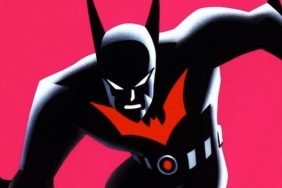If you weren’t blinded by the incredible imagery of Interstellar, then there’s a good chance you were blinded by the science. The film, about venturing into the furthest reaches of space to find a new home for humanity after Earth’s resources dwindle, hews as closely to hard science as practically any film has dared, thanks to an extremely researched screenplay by Jonathan Nolan (director Christopher Nolan’s brother), and input from theoretical physicist Kip Thorne.
As you sit down to watch Interstellar at home, you may find yourself looking more closely at the science of Interstellar and wondering about some of its mysteries. We talked to Jonathan Nolan on the phone to delve into the genesis of the project, the movie’s idea that familial love is a scientific phenomenon, and whether the film represents a genuine paradox.
Be warned: SPOILERS for Interstellar lie ahead. Interstellar is now available on Blu-ray, DVD and VOD.
Check Out: Composer Hans Zimmer on ‘Interstellar,’ Love and EDM (Exclusive Interview)
CraveOnline: Interstellar started off as a Steven Spielberg project, and now it’s become what really feels like a Christopher Nolan and Jonathan Nolan movie. Tell me about that development process between the two. What was the biggest adjustment?
Jonathan Nolan: From my perspective it was fairly seamless. It was an absolute pleasure developing the project, not just with Steven Spielberg but also with Kip Thorne and Lynda Obst. The project originated with Lynda [and] her great friendship with Kip. Kip is… the easiest way to describe him is a complete rock star within the world of astrophysics. So from the beginning the partnership was with Kip, developing a space exploration film grounded in good physics. Steven’s commitment to that was unwavering as we developed it for a few years, and then when Chris came to the project he took on the same mantle, of saying, let’s try to tell the story of the next chapter in… really, the next chapter in the human story, and let’s try to do it with as grounded an approach as possible.
Now obviously there are certain flights of fancy that you have to take along the way, that the fully grounded version of a space exploration film… You know, when I pitched it to Steven, when I got the job in the first place, [I said] it would be ten minutes long, because we’re not going! [Laughs.] Because the money’s not there. We’re no longer committed to this area. That has changed. Nothing to do with the filmmaking team behind the film, but ten years in – I think I started working on the project in 2006, was the first meeting – almost a decade later what feels like it has changed, shifted radically from when I started working on the project, is it feels like we’re in a much more optimistic moment in terms of space exploration. That feels like a very big shift.
Tell me about the scientific accuracy. Obviously there are certain things that, just to make a movie, you might have to fudge a bit. Was there any moment when Kip Thorne just threw up his hands and went, “Fine! Put it in the film!”
[Laughs.] No. I think we all embraced the idea that at certain points you have to have, like I said, a flight of fancy. We endeavored to build the strongest grounding, sort of a runway if you will, from which the ideas in the film could take off. All of the ideas in the film, even the most exotic ones, are grounded in extensive conversations with Kip and other scientists, trying to understand the limitations of the physical universe around us. Kip’s book, the companion piece to the film is there for people who are interested in the science of it or had questions about it. You know, we couldn’t make a five-hour film, so my original draft kind of slowed down and explained what we were doing at every place we were doing it. I was very grateful that my brother excised that material and we just got into it.
For instance, there is a completely grounded explanation for what’s happening inside that black hole. Grounded in terms of imagining what an intelligence, what an essentially extra-dimensional intelligence would be capable of doing and what it wouldn’t be capable of doing. So there’s thought that goes into all of these things.
The idea that gravitation, or that gravity would provide the mechanism of communication across the face of the universe or even in time, spacetime, is one that’s well supported… well, let me qualify that. There is something, and it’s based on our reading of the science, our conversations with Kip, there is something odd about gravity. Of all of the four fundamental forces of the universe – gravitation and electro-magnetism and the weak and strong nuclear forces – gravity is the one that does not seem to fit quite within Einstein’s conception of the universe and the quantum mechanics. This famously [contributed to] his inability to create a unified theory hinges in part on gravity and quantum gravity.
So the idea that gravity might be able to slip out of what we understand to be our universe, what we mean our three- or four-dimensional brain… and there is one model for the universe that we use within the film and Kip details it in his book, because we don’t really understand the larger extradimensional structure of the universe. There are lots of good theories to explain it: string theory, M-theory, you know, and that family of theories all endeavor to try to explain some of the things that we can’t explain within our observable universe. We’ve used one model, it has some exotic features to it, but the idea that gravity might be something we could use to communicate over vast distances – not just in terms of space but in terms of time – is entirely consistent with that theory of the shape of the universe.
So there is – not to belabor the point, but like I said, the movie would be five hours long and so would the interview if we went into all the details of it – but there is an awful lot of thought that has gone into all of these sorts of things, but we haven’t stopped at every moment to try to articulate exactly what’s going on. [Laughs.] And just the last thought on that one: there are plenty flights of fancy in there, but they are all within fair game speculation. That is, we’ve tried to speculate only in places where there is room for speculation.







